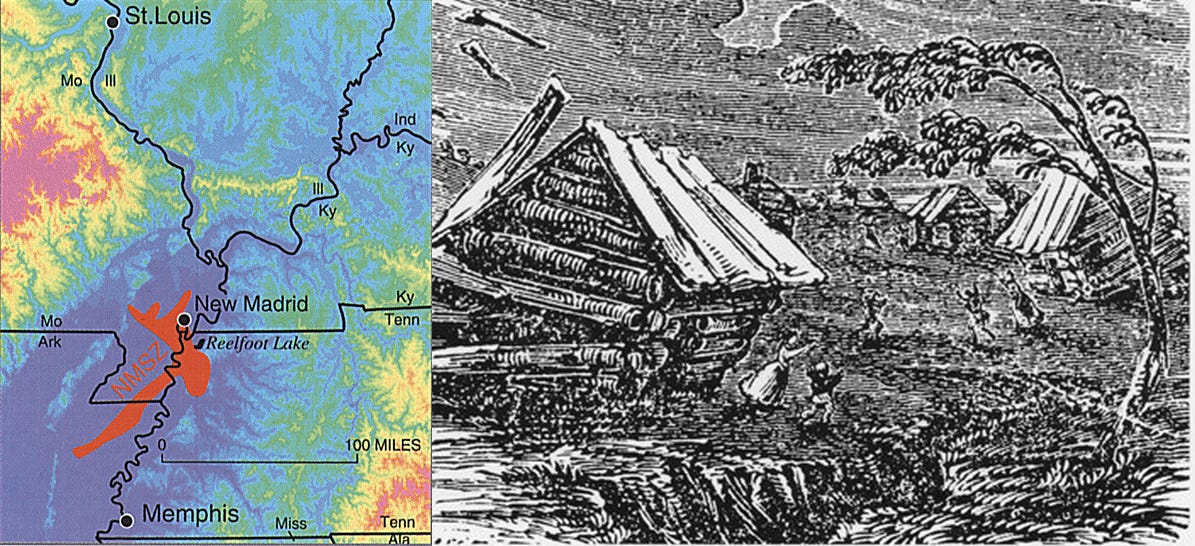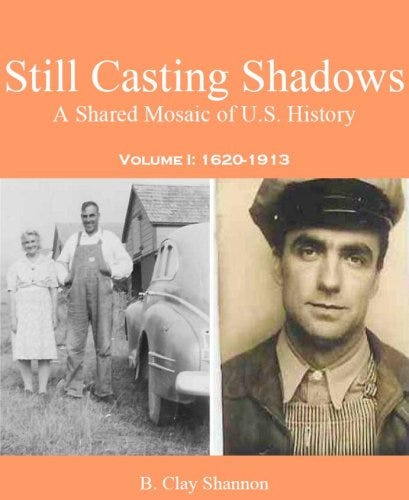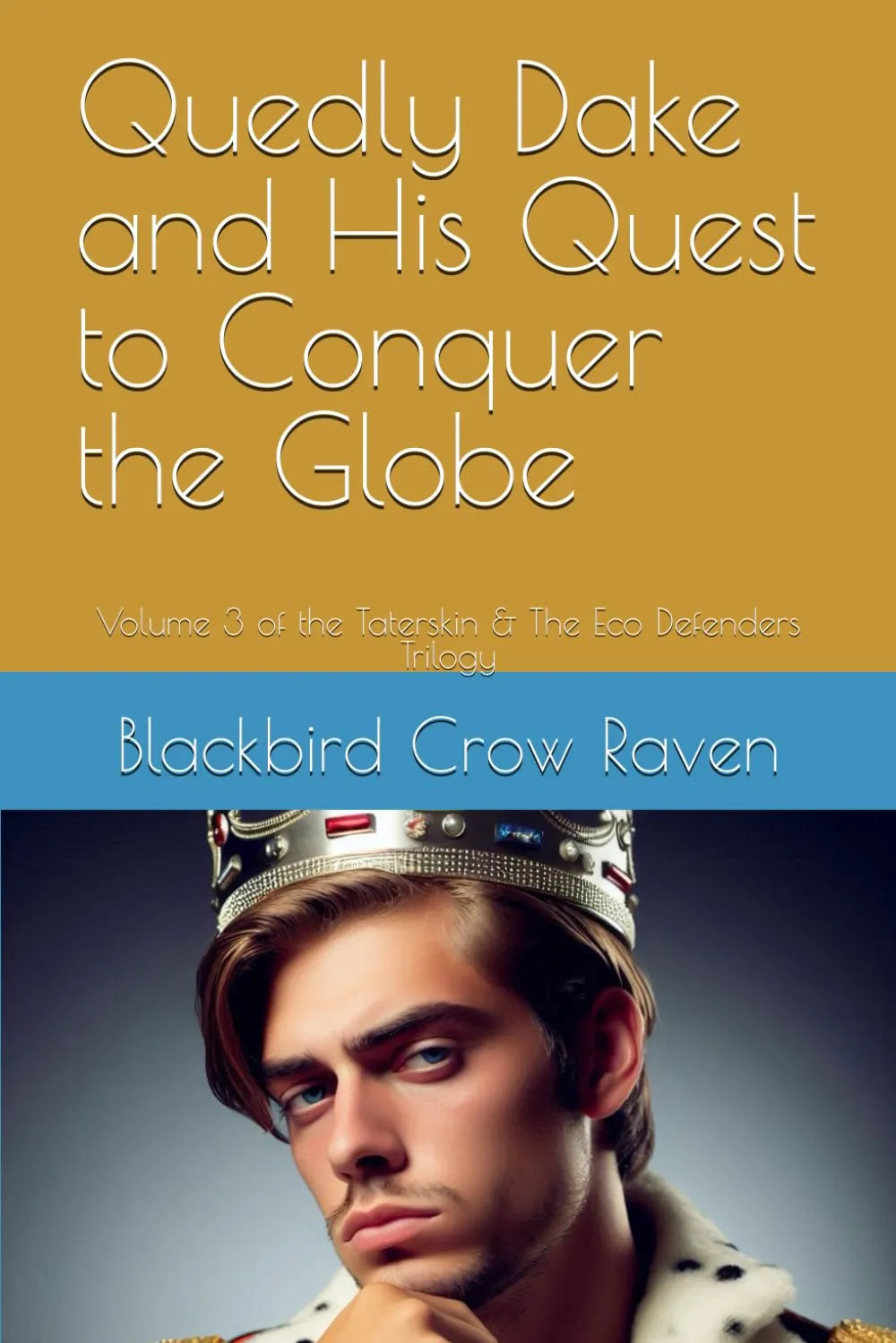1812 — Worst New Madrid Earthquake
Note: The following is an excerpt from my 2006 book Still Casting Shadows: A Shared Mosaic of U.S. History, Volume 1: 1620-1913Nobody in the scientific community in the early part of the 19th century would have considered southeastern Missouri to be earthquake country. Yet a monstrous earthquake, epicentered near New Madrid, Missouri, began in the early morning hours of December 16th, 1811, and continued, with recurring aftershocks, into the early part of 1812. The deadliest quake shook the earth on February 7th of that year. It shook to pieces cabins in St. Louis, Missouri, and 400 miles away in Cincinnati; uprooted trees in Kentucky; rang church bells 1,000 miles distant in Boston; and rattled plates and saucers way up in Montreal, Canada.
In all, an area encompassing what would become twenty-seven states was affected, as well as parts of Canada. Five thousand square miles were permanently changed, including the disappearance of some islands which had been in the Mississippi River (often used as hideouts by bandits).
The strongest of these New Madrid temblors was the biggest earthquake in U.S. history; although seismographs were not available at the time, it has been estimated that at least three of the quakes in the New Madrid series (December 16th, 1811, and both January 23rd and February 7th in 1812) exceeded 8.0 on the Richter scale [the February 7th quake has been estimated as having registered 8.6].
It is worth noting that each full number on the scale represents a force tenfold greater than the preceding full number—in other words, an 8.0 earthquake is ten times as strong than a 7.0 earthquake (such as the one that struck San Francisco in 1906).
The power unleashed during the most severe quake, on February 7th, 1812 was so massive that the 2,300 mile long mighty Mississippi changed course, diverted water (one consequence of which was the forming of Reelfoot Lake in Tennessee), created temporary waterfalls that claimed several boats—which capsized when they plunged over the falls—, opened up fissures below the River which generated large whirlpools that sucked boats into its depths, killed dozens or possibly hundreds of people (even though the region was sparsely settled), and even caused the mighty Mississippi River to run backwards for a time [a phenomenon which has been termed a “fluvial tsunami”].
A note regarding the number of fatalities caused by the series of enormous jolts: Only one death was officially attributed to the quake. However, as many isolated cabins and campsites disappeared without a trace [including the village of Little Prairie, Missouri], it is highly probable that many people perished. As with the Peshtigo firestorm that would take place sixty years later in remote northeastern Wisconsin, it is impossible to know how many died in the cataclysm.
The Mississippi River has been called many things: The Father of Waters. The Great Waters. The Mother of Rivers—well, although one account states that the word “Mississippi” stems from the Indian word “Messa-Chepi,” meaning “Mother of the Rivers,” another version says that the original Indian word was actually “Nemaesi-Sipu,” which means “Fish River.” Yet another account asserts that the name comes from the Chippewa word “Micisibi,” which means “Big River.” And so it goes: the communication gap between the white men and the red men caused many misunderstandings, and this is a rather innocuous illumination of just how misunderstood the Indians often were.
Although the sobriquet rightly belongs to the Missouri River, some even call the Mississippi “The Big Muddy” (it is the Missouri whose brownish contribution makes the Mississippi muddy at their juncture near St. Louis). The French initially called the Mississippi the Colbert River, and later the St. Louis River. The Spanish before them had referred to it as la Palissad.
The town of New Madrid, situated in the boot-heel section of southeastern Missouri, the epicenter of the great series of quakes, was named such because at the time of its founding the area was owned by Spain (when Daniel Boone left Kentucky in a huff and settled in Missouri, he was first required to become a Spanish citizen). Like Cairo, Illinois, fifty miles north and on the other (eastern) shore of the Mississippi, the name of the town is not pronounced as might be expected. Although the area around Cairo is known as “Little Egypt,” the locals pronounce it KAY-row, not KY-row. As crazy as it may sound, New Madridians pronounce the name of their home town, not like the capital of Spain, but “New MAD-rid.”
On the left below is my paternal grandfather Theodore Roosevelt Shannon (born in California in 1902) and his mother Gertrude “Gertie” Bailey Shannon (born in Kansas 1883); on the right is my maternal grandfather Albert Lee Benjamin Kollenborn (born in Missouri 1907).
Questions: Have there been any larger earthquakes (in terms of Richter Scale reading, damage caused, or how widely felt the quake was) than the New Madrid Quake of February 7, 1812? How does the 1883 Krakatoa eruption compare? Have you ever felt an earthquake? If you have felt more than one, which one was the worst, and why? Is it likely that an earthquake will strike near you soon?1992 — European Union
public domain images from wikimedia commons
Follow the money trail. Putting aside their age-old differences which had led to many wars, especially between England and France, the “United States of Europe” was formed on this date in 1992 at the Maastricht Treaty of European Union, primarily for the economic benefit that would accrue. The signers to the Treaty agreed to use a common currency, the Euro, and cooperate in many other ways, also.
Alphabetically, the first dozen members of the EU (European Union) were Belgium, Denmark, France, Germany, Greece, Great Britain, Ireland, Italy, Luxembourg, the Netherlands, Portugal, and Spain. The Union has grown considerably but also lost a member since then. There are now 27 members, with the addition of Austria, Bulgaria, Croatia, Cyprus, the Czech Republic, Estonia, Finland, Hungary, Latvia, Lithuania, Malta, Poland, Romania, Slovakia, Slovenia, and Sweden having joined, and one original member nation, Great Britain, severing ties with the Union (“Brexit”).
Questions: How many countries are there in Europe? Are all of the nations that are considered to be part of Europe located on the European continent? How many European countries are not part of the EU? What are the advantages and disadvantages a country weighs before applying for membership? What are the advantages and disadvantages for the EU as a whole when a new member joins or leaves? How does the EU differ from the 50 United States of America? How does the EU differ from the 31 United Mexican States?








